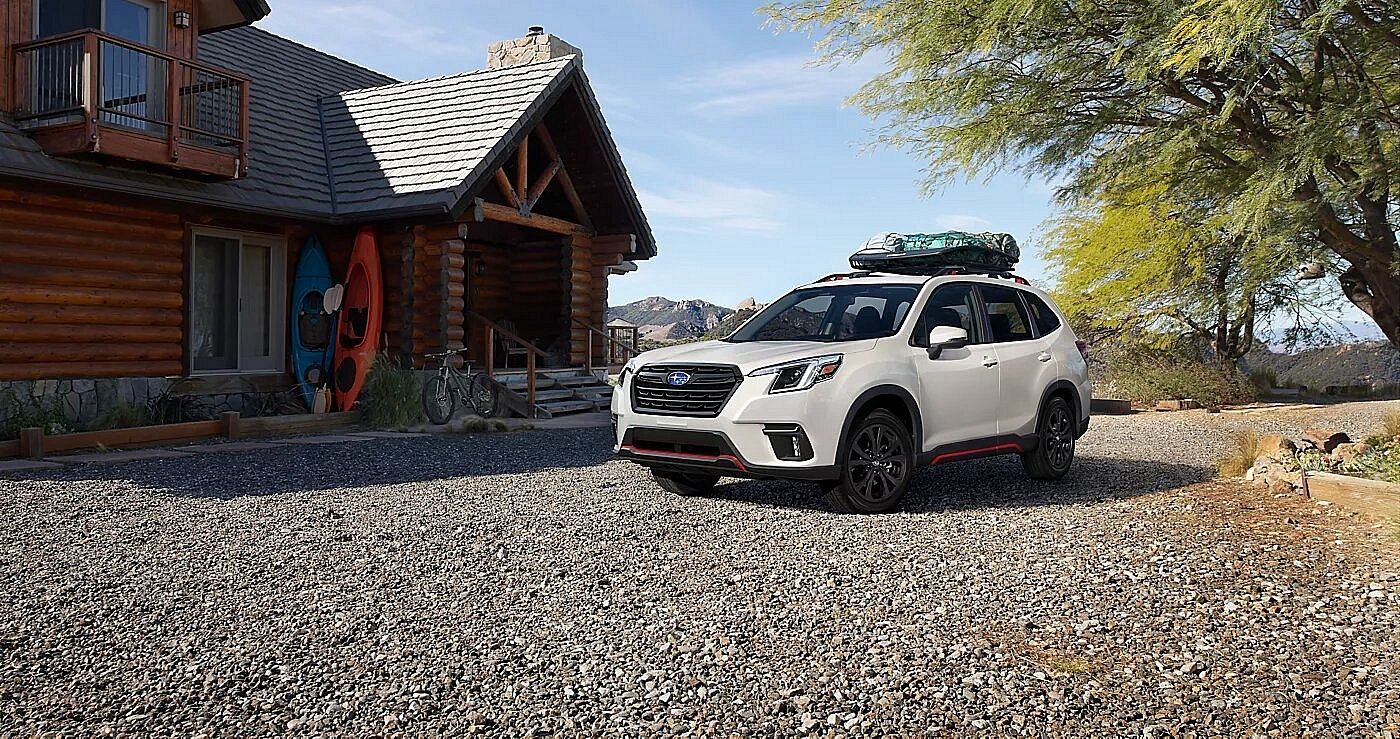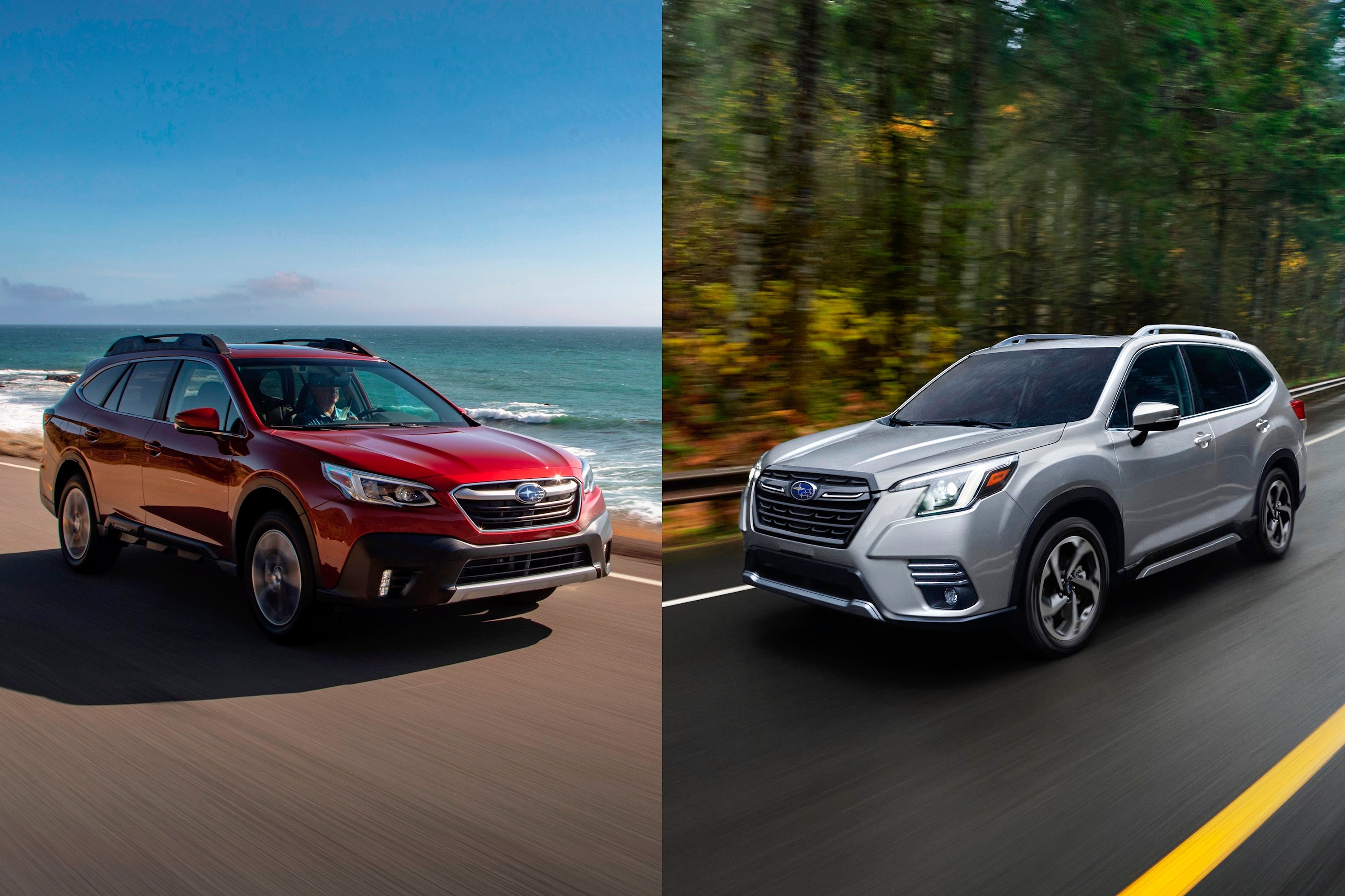
While wagons and SUVs are not traditionally considered direct rivals, the lifted Outback is more rugged than most wagons of its kind, making for an interesting conundrum for Subaru fans shopping for a new car. And, in an SUV-obsessed market, it's notable that the Outback has outsold the Forester in 2022, but which is better? The Japanese automaker's customer base has always valued all-wheel drive, more than a hint of soft-roading ability, and practical cabins that can withstand the rigors of family use whether in the city or the great outdoors. Both of these Subaru models cover all those bases, so what do you do if they're both on your shortlist? That's a question we'll attempt to answer in this comparison of two of Subarus most popular models.
Dimensions And Weight: Outback Has The Bigger Footprint
The Forester is a compact crossover that competes directly with models like the Honda CR-V and Toyota RAV4. The Outback can be considered a less luxurious and cheaper version of mildly rugged wagons like the Volvo V60 Cross Country and Audi A4 allroad.
Side by side, the Outback is 9.2 inches longer and 2.7 inches wider than the Forester. Unsurprisingly, though, it's the Forester SUV that's taller at 68.1 inches relative to the Outback's 66.1 inches.
Height aside, the generally larger Outback is the heavier vehicle, with the base model checking in at 3,641 pounds compared to the Forester's 3,454 pounds of weight for the base models. Both cars have the same 8.7 inches of ground clearance in standard form, but there are off-road-focused Wilderness versions of each that raise the ground clearance to 9.2 inches (Forester) and 9.5 inches (Outback).
Based on these numbers, we can see that the SUV body style of the Forester isn't necessarily an advantage.
Interior Space: Closely Matched
In this Subaru Outback Vs. Forester comparison, the interiors are very closely matched on paper. The Forester's base model provides 111.6 cubic feet of interior room and 107.6 cubic feet in most other trims. The Outback has 109 cubes of passenger space and 107.5 if the moonroof is equipped.
Rear legroom is what counts in family models, and the difference is once again negligible. The Outback offers 39.5 inches to the Forester's 39.4 inches. In terms of headroom, the Forester pips the Outback in front (up to 41.2 inches vs. the maximum of 40.1 inches), while at the back, the Forester also has more head clearance as long as you don't equip the moonroof. Both cars are pretty much equally capable of carrying three passengers at the back, as the Outback has just 0.2 inches of extra shoulder room here.
Cargo space is more of a differentiator, though, with up to 28.9 cubic feet of cargo room offered by the Forester compared to the Outback's 32.6 cubes with the seats up. With the seats down, the Forester's base model has 74.2 cubes to spare and 69.1 for all other trims. The Outback is consistent with its 75.6 cubes across the range when the second row is lowered.
Drivetrains, Gas Mileage, And Towing: Outback More Powerful But Less Efficient
Both models come with Subaru's trademark 2.5-liter flat-four engine making 182 horsepower and 176 lb-ft of torque, but the Outback can be equipped with a more powerful 2.4-liter turbocharged engine that delivers 260 hp and 277 lb-ft of torque. The turbocharged engine comes with the Onyx Edition XT, Limited XT, Touring XT, and off-road-based Wilderness trims.
Unfortunately, our reviewers have found the base 2.5-liter naturally-aspirated engine to be underpowered and laborious for things like highway merging and overtaking. However, the CVT transmissions on all models and trims are smooth and Subaru's symmetrical all-wheel-drive (AWD) system is superb. Seriously, when it comes to affordable AWD systems, nobody does it better than Subaru.
Fuel economy for the 2.5-liter engine comes in at 26/33/29 mpg city/highway/combined for the Forester, but the Wilderness trim drops to 25/28/26 mpg. With the same engine, the Outback proves to be nearly as efficient in non-Wilderness guise, returning 26/32/28 mpg despite being the heavier, larger vehicle.
The drawback to decent power with the turbocharged 2.4-liter engine for the Outback is in fuel economy. It drops to 22/29/25 mpg or 21/26/23 mpg in Wilderness guise.
Depending on the configuration, the Forester is rated to tow between 1,500 and 3,000 pounds while the Outback, surprisingly, is rated higher at 2,700 to 3,500 lbs depending on configuration. The Outback also has a larger fuel tank size, capable of holding 18.5 gallons of fuel to the Forester's 16.6-gallon capacity.
In the Forester Vs. Outback drivetrain battle, we'd choose the latter's turbocharged mill every day of the week despite the gas mileage penalty.
Safety: Upholding Subaru's Stellar Reputation
Subaru pushes safety on its cars hard, so it's no surprise both models rate highly when it comes to the well-being of their occupants if things go horribly wrong. Both models come with Subaru's EyeSight suite of safety tech that includes adaptive cruise control, automatic emergency braking, automatic high beams, and lane departure warning as standard. Unfortunately, you have to go up the trim levels to get blind-spot monitoring as an included feature, as well as cross-traffic alert.
When push comes to shove, the current generation of Outback and Forester both claimed the 2022 Top Safety Pick+ award from the IIHS and a five-star overall safety rating from the NHTSA for the 2023 model year. It's worth noting that the Outback's 2023 model includes an update to the EyeSight system's software, front camera view, and electronic brake booster.
Pricing: More Car, More Money
The Subaru Outback starts at $28,395, while the Forester comes in at $26,395. If you start going up the Forester's six-trim ladder, it tops out at $36,495 for the Touring model. The Outback has nine trim levels and tops out at $42,295 with the Touring XT. The off-road-centric Wilderness models clock in at $34,020 for the Forester and $38,445 for the Outback version.
The Forester is obviously the cheaper option, but one has to take into account its smaller size and the absence of a turbocharged engine option.
Verdict: Forester Or Outback?
A base Forester is cheaper than a base Outback, but for most people, comparing these two vehicles will come down to a preference for body style.
Going up the trims, the Outback becomes more luxurious than the Forester and has the option for a more powerful engine at the expense of MSRP and fuel economy. However, this engine does markedly improve the driving experience. The bottom line is that they are both ranked highly for safety, reasonably efficient, and both are available with the Wilderness trim for more intensive off-road excursions, but the Outback is more expensive in general while coming with more premium features.
Subaru has managed to build two models that are similarly capable while diverging in personality and design. If money was no object, we'd go for the turbocharged Outback while helping to preserve the life of the increasingly rare wagon. But even a base Forester is a superb crossover that ticks most boxes for adventurous types, so overall, it's easy to make a strong case for either of these two competent vehicles.

